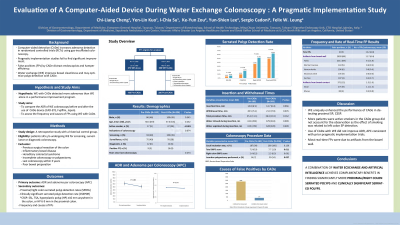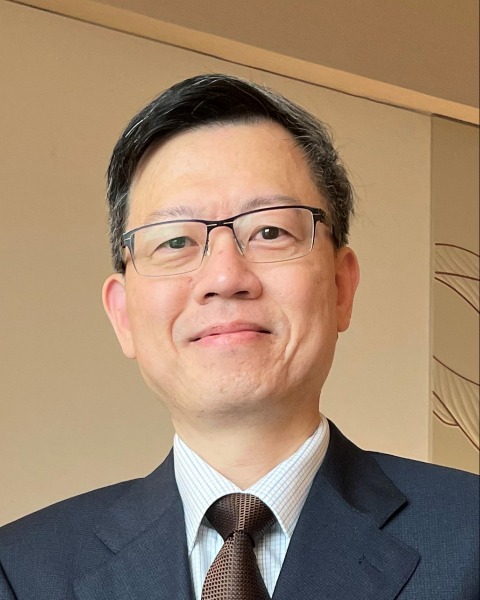Monday Poster Session
Category: Colon
P1610 - Evaluation of a Computer-Aided Detection Device During Water Exchange Colonoscopy: A Pragmatic Implementation Performance Improvement Study
Monday, October 23, 2023
10:30 AM - 4:15 PM PT
Location: Exhibit Hall

Has Audio

Chi-Liang Cheng, MD
Evergreen General Hospital
Taoyuan, Taoyuan, Taiwan (Republic of China)
Presenting Author(s)
Chi-Liang Cheng, MD1, Yen-Lin Kuo, MD1, I-Chia Su, MD1, Sergio Cadoni, MD2, Ke-Yun Zou, 3, Yun-Shien Lee, PhD3, Felix W. Leung, MD, FACG4
1Evergreen General Hospital, Taoyuan, Taoyuan, Taiwan; 2CTO Hospital, Iglesias, Sardegna, Italy; 3School of Health Technology, Ming Chuan University, Taoyuan, Taoyuan, Taiwan; 4Sepulveda ACC/VAGLAHS/UCLA, North Hills, CA
Introduction: Real-time computer-aided detection (CADe) devices have been shown to increase adenoma detection rate (ADR) and adenoma per colonoscopy (APC) in randomized controlled trials (RCTs) using gas-insufflated colonoscopy. But real-life implementation studies conducted in community hospitals, including some RCTs (AI-DETECT trial, AI-SEE trial), failed to find significant performance improvement (Gastroenterology 2023;164:481; Endoscopy 2023;55:313; DOI: 10.14309/ajg.02239). Water exchange (WE) colonoscopy increases bowel cleanliness and may optimize polyp detection with CADe. We hypothesized that WE with CADe would detect more adenomas than WE alone. In this study, we evaluated the use of CADe during WE colonoscopy in community-based practice.
Methods: This was a pragmatic implementation study conducted in Evergreen General Hospital, Taoyuan, Taiwan. Our endoscopy suite was equipped with a CADe device (CAD EYE, Fujifilm, Japan) on Feb 2, 2023. We collected data on all WE colonoscopies performed in ≥45 y/o patients of all indications with the use of CADe between Feb 3 and May 15, 2023 (CADe group) and compared with a corresponding 3-month period (Nov 2022 - Jan 2023) before CADe implementation (non-CADe group). All procedures were performed by 3 endoscopists with high-definition colonoscopes. The primary outcomes were ADR and APC. Secondary outcomes included serrated polyp (SP) detection and procedural times.
Results: Table shows all the results. A total of 395 patients (206 with CADe) were enrolled, with similar baseline demographics except more patients were active smokers in the CADe group. All procedural times were comparable. There were no significant differences in the ADR and APC between the CADe and non-CADe groups (51.5% vs 61.9%, P = 0.365 [ADR]; 1.25 vs 1.31, P = 0.714 [APC]). The use of CADe significantly increased the SP detection rates in the right and proximal colon (51.5% vs 35.9%, P = 0.002 [right]; 62.6% vs 49.7%, P = 0.01 [proximal]), along with the clinically significant SP detection rate (18.0% vs 9.5%, P = 0.016). More insertion polypectomies were performed in the CADe group.
Discussion: The use of CADe did not improve ADR or APC consistent with prior pragmatic implementation trials, but significantly increased the detection of SP during WE colonoscopy. The complimentary benefits of combining WE and CADe on SP detection deserves further study.
Disclosures:
Chi-Liang Cheng, MD1, Yen-Lin Kuo, MD1, I-Chia Su, MD1, Sergio Cadoni, MD2, Ke-Yun Zou, 3, Yun-Shien Lee, PhD3, Felix W. Leung, MD, FACG4. P1610 - Evaluation of a Computer-Aided Detection Device During Water Exchange Colonoscopy: A Pragmatic Implementation Performance Improvement Study, ACG 2023 Annual Scientific Meeting Abstracts. Vancouver, BC, Canada: American College of Gastroenterology.
1Evergreen General Hospital, Taoyuan, Taoyuan, Taiwan; 2CTO Hospital, Iglesias, Sardegna, Italy; 3School of Health Technology, Ming Chuan University, Taoyuan, Taoyuan, Taiwan; 4Sepulveda ACC/VAGLAHS/UCLA, North Hills, CA
Introduction: Real-time computer-aided detection (CADe) devices have been shown to increase adenoma detection rate (ADR) and adenoma per colonoscopy (APC) in randomized controlled trials (RCTs) using gas-insufflated colonoscopy. But real-life implementation studies conducted in community hospitals, including some RCTs (AI-DETECT trial, AI-SEE trial), failed to find significant performance improvement (Gastroenterology 2023;164:481; Endoscopy 2023;55:313; DOI: 10.14309/ajg.02239). Water exchange (WE) colonoscopy increases bowel cleanliness and may optimize polyp detection with CADe. We hypothesized that WE with CADe would detect more adenomas than WE alone. In this study, we evaluated the use of CADe during WE colonoscopy in community-based practice.
Methods: This was a pragmatic implementation study conducted in Evergreen General Hospital, Taoyuan, Taiwan. Our endoscopy suite was equipped with a CADe device (CAD EYE, Fujifilm, Japan) on Feb 2, 2023. We collected data on all WE colonoscopies performed in ≥45 y/o patients of all indications with the use of CADe between Feb 3 and May 15, 2023 (CADe group) and compared with a corresponding 3-month period (Nov 2022 - Jan 2023) before CADe implementation (non-CADe group). All procedures were performed by 3 endoscopists with high-definition colonoscopes. The primary outcomes were ADR and APC. Secondary outcomes included serrated polyp (SP) detection and procedural times.
Results: Table shows all the results. A total of 395 patients (206 with CADe) were enrolled, with similar baseline demographics except more patients were active smokers in the CADe group. All procedural times were comparable. There were no significant differences in the ADR and APC between the CADe and non-CADe groups (51.5% vs 61.9%, P = 0.365 [ADR]; 1.25 vs 1.31, P = 0.714 [APC]). The use of CADe significantly increased the SP detection rates in the right and proximal colon (51.5% vs 35.9%, P = 0.002 [right]; 62.6% vs 49.7%, P = 0.01 [proximal]), along with the clinically significant SP detection rate (18.0% vs 9.5%, P = 0.016). More insertion polypectomies were performed in the CADe group.
Discussion: The use of CADe did not improve ADR or APC consistent with prior pragmatic implementation trials, but significantly increased the detection of SP during WE colonoscopy. The complimentary benefits of combining WE and CADe on SP detection deserves further study.
Disclosures:
Chi-Liang Cheng indicated no relevant financial relationships.
Yen-Lin Kuo indicated no relevant financial relationships.
I-Chia Su indicated no relevant financial relationships.
Sergio Cadoni indicated no relevant financial relationships.
Ke-Yun Zou indicated no relevant financial relationships.
Yun-Shien Lee indicated no relevant financial relationships.
Felix Leung indicated no relevant financial relationships.
Chi-Liang Cheng, MD1, Yen-Lin Kuo, MD1, I-Chia Su, MD1, Sergio Cadoni, MD2, Ke-Yun Zou, 3, Yun-Shien Lee, PhD3, Felix W. Leung, MD, FACG4. P1610 - Evaluation of a Computer-Aided Detection Device During Water Exchange Colonoscopy: A Pragmatic Implementation Performance Improvement Study, ACG 2023 Annual Scientific Meeting Abstracts. Vancouver, BC, Canada: American College of Gastroenterology.
